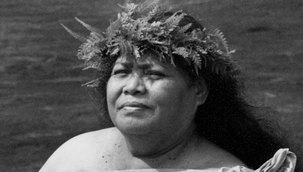
Holo Mai Pele
An epic hula that tells the tale of Pele and her sister Hi‘iaka.
- Filmmaker(s)
- Catherine Tatge
- Category
- Full-Length Film
- Subject Matter
- Identity, Culture, Arts & Music
- Featured In
- 25 in 25
In 2001, when Holo Mai Pele appeared on PBS's Great Performances—the nation’s longest-running and most prestigious TV series devoted to the performing arts—it represented the most visible treatment of hula to appear in the national media. It was the first time that anything from the Pacific had been selected for the program. This documentary, by acclaimed director Catherine Tatge with revered kumu hula Pualani Kanaka‘ole Kanahele and Nalani Kanaka‘ole, tells the story of the volcano goddess Pele and her favorite sister Hi'iaka. While the performance is stunningly beautiful, at the same time, it is deeply spiritual.
-
More About the Film
When the dancers of Halau o Kekuhi premiered their hula epic, Holo Mai Pele, to a rapt audience on Maui in 1995, they created a palpable shift in the public's awareness—of hula as an art form, of Hawaii's history and genealogy, and of what it means to be Hawaiian."Our whole purpose was to take hula up to a different level," comments Pualani Kanaka‘ole Kanahele. She and sister, Nalani Kanaka‘ole, are the originators of Holo Mai Pele. They are also kumu hula of the Hilo-based Halau o Kekuhi.
"People often look at hula as strictly entertainment, and some people, even as frivolous. There is hula that is entertainment, and there is hula that is very spiritual and which comes from a different place. All of it is hula. We'd like to show the public hula from a different place—hula that's very serious and deeply connected to many generations of history and nature."
In the months following, Halau o Kekuhi took this three-hour, five-act drama about volcano goddess Pele and her favorite sister, Hi‘iaka, to O‘ahu, Kaua‘i, and the Halau's home island of Hawai‘i. With increasing momentum, displaying a life of its own, Holo Mai Pele transfixed sold-out audiences each time.
Producer Catherine Tatge worked with the Kanaka'ole sisters for two years before filming. Among their challenges was condensing the original three-hour drama into one hour, and including narration and subtitles in English. Only excerpts from the chants were translated into English for the subtitles.
"I think of subtitles as signposts, to give some kind of feeling of what's in the original chants," says D. Mahealani Dudoit, narration writer. Tatge adds, "We didn't translate everything precisely because the experience is so strong and the work speaks for itself."
While the subtitles express the poetry of the chants, the narration helps provide the storyline. In Holo Mai Pele, Pele sends her trusted sister, Hi‘iaka, to Kaua‘i to fetch Lohi‘au, the handsome prince she loves. On her journey across the archipelago, Hi‘iaka accumulates the mastery needed for the task and for her own development. She learns to give life and to take life, and she returns to her home island as an equal to Pele, with her own consciousness and status significantly elevated.
The material is grounded in classic Hawaiian myth and art form, yet presented in ways that are strikingly contemporary. From concept to choreography to staging, lighting, costuming, and the sheer power of the dance, the drama is singularly Hawaiian, yet evocative of classic theatrical traditions such as opera, ballet, and kabuki.
The halau's distinctive ‘aiha‘a style is vigorous and low to the ground, its bent-knee stance personifying power emanating from the earth and its elements. Three generations of the Kanaka'ole family appear in the production, and many of the dances were passed down through direct transmission from matrilineal ancestors. Daughters of the revered Edith Kanaka‘ole, Pualani, and Nalani are recognized as the guardians of Pele-related hula, carrying hundreds of years of knowledge within the seven-generation halau.
"All these elements," Tatge says, "have been integrated successfully in the film."








